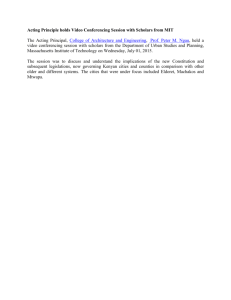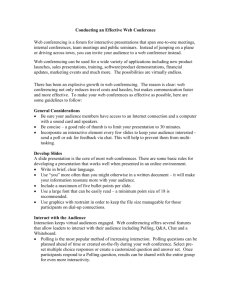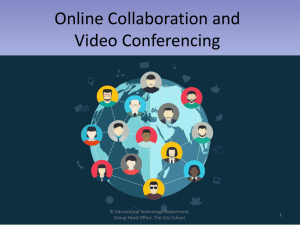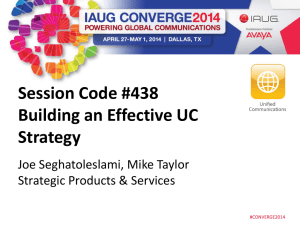Sales Force Expansion
advertisement
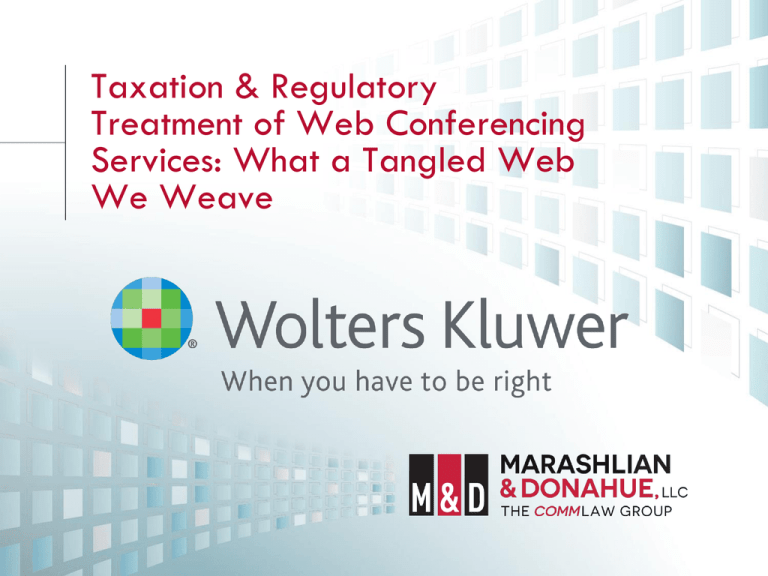
Taxation & Regulatory Treatment of Web Conferencing Services: What a Tangled Web We Weave Taxation & Regulatory Treatment of Web Conferencing Services: Outline of Presentation Part 1: FCC Regulatory Treatment of Web Conferencing Part 2: State and Local Tax Treatment of Web Conferencing Part 3: Where does that leave us now? 2 Background of FCC Treatment of Conferencing Services Timeline of FCC Decisions: • Pulver (2004) – Non-PSTN conferencing • InterCall (2008) – Stand-alone audiobridging/conferencing • MeetingOne (2011) – IP-Based audio conferencing (Appeal to FCC pending) • Webex (2013) – Online Collaboration (Appeal to FCC pending) 3 Pulver Free World Dialup (2004) Non-PSTN conferencing classified as an Information Service: • Free World Dialup (FWD) allowed internal, Non-PSTN communications between members via voice, video or text • Membership based, requires broadband connection and softphone • Unique 5 or 6 digit FWD number assigned to each member • Conference bridging capabilities • FCC found the service to be an information service (2004) 4 InterCall Services Description Background: InterCall provides stand-alone audio conferencing services that includes certain features: • validation functions, • collect billing and participant information, • enable participants to record, delete playback, mute and unmute, and access operator assistance • FCC described InterCall as marketing audio, video and web conferencing; however, record is not clear InterCall’s service included anything beyond audio 5 InterCall Order (2008) Stand-alone audio-bridging classified as telecommunications: • InterCall Order - FCC found InterCall’s stand-alone conferencing service (audio-bridging) to be telecommunications subject to USF contribution. Features offered with audio-bridging were not sufficiently integrated to change the service to an information service – validation functions, collect billing and participant information, and enable participants to record, delete playback, mute and unmute, and access operator assistance – Features did not alter fundamental character of service – Customers could access conferencing without accessing features Note: This service was connected to the PSTN 6 InterCall Order Consequences FCC Ruling created a major change in the regulatory treatment of conferencing: • InterCall Order declares audio bridging / conferencing services to be “telecommunications” – Subject to Title II regulations and USF contributions • Before InterCall Order, conferencing industry operated subject to rules governing “information services” – “End user” of telecommunications – Fees / Taxes on telecommunications paid to supplier of telecom – Significantly lower administrative burdens and exposure • FCC extended findings to all similarly-situated providers – “Virtual office” providers impacted State PUC registration potentially required as a result. 7 MeetingOne Service Description Background: MeetingOne provides IP-based audio conferencing services that includes certain features: • MeetingOne offers IP-based audio conferencing service – Accessed via a toll-free number – Accepts inbound legs of a conference in IP at the inbound provider’s IP gateway, routes the packets over its network utilizing SIP and RTP, combines the packets with other packets from the conference, and hands off in IP at the outbound provider’s IP gateway – Offers additional features such as call recording and retrieval • MeetingOne also noted that its service has the capability of supporting direct SIP-based computer-to-computer connections, but it did not yet offer that service. 8 MeetingOne Decision (2011) IP-Based PSTN-connected audio conferencing classified as telecommunications by the WCB on USAC appeal: • The Wireline Competition Bureau (WCB) concluded that MeetingOne’s services are functionally equivalent to the audiobridging services at issue in the InterCall Order and that MeetingOne’s use of IP technology is essentially IP-in-themiddle (but still PSTN connected) and does not alter the nature of the service. • Notably, however, in the MeetingOne Order, the WCB declined to address purely SIP-based conferencing because, although MeetingOne had the capability to offer such a service, it was not offering it at the time of the decision. • The WCB has delegated authority to rule on USAC appeals, but it is not considered a final FCC decision. 9 InterCall Reconsideration Order (2012) Identified separate audio/voice component and computer capabilities of a bundled service offering: • FCC upheld prior decision that audio-bridging is telecommunications. • Clarified that the additional services “bundled with the audio bridging service, such as whiteboarding and other computer capabilities that may be used simultaneously with the voice teleconference” are not sufficiently integrated with audio conferencing services to be considered a single product. – An important element of this determination was the fact that the “customer can conduct its conference call with or without accessing these features.” • Appeal of InterCall by other parties denied on standing grounds so no opportunity for judicial review of merits of FCC decision. 10 InterCall Reconsideration (cont’d) Elimination of “functional-integration” standard: • Before InterCall, “functional-integration” prevailed • Combination of information service and telecommunications was viewed entirely as information service - up until InterCall • InterCall / MeetingOne not only killed this concept; FCC now appears poised to turn it on its head! FCC: “[W]e confirm that under our existing requirements, a provider offering a bundled service comprised of telecommunications services and information services may not treat the entire bundled service as an information service for purposes of USF contribution assessment, but must instead apportion its end user revenues between telecommunications and non-telecommunications sources.” InterCall Recon, ¶ 13 11 Webex Service Description Background: Webex provides an online collaboration tool along with a separate audio conferencing feature: • WebEx is an online collaboration tool that allows its users to share information and create work product through audio, video and computing capabilities. • Webex provides: Desktop screen sharing, document sharing, web/browser sharing, whiteboarding, remote key & mouse control, video integration, host controls, chat features, presence information, and an audio component (separately priced) – Webex can call participate – Participate can access audio via non-interconneced VoIP – Participate can dial-in via toll/toll-free number (separately priced) 12 Webex USAC Audit Decision USAC identified a separate audio/ voice component to Webex’s offering. This was an offshoot of the FCC’s InterCall ruling: • USAC determined that WebEx’s computer capabilities (desktop and document sharing services, active talker and active speaker features, etc.) are information services. • However, USAC found the separate audio component to be telecommunications subject to USF contribution. – USAC relied on fact that the audio feature of WebEx could be substituted with a customer’s own audio and that meeting participants could use WebEx’s audio feature without using other features 13 InterCall FCC Activities In Relation to Webex InterCall seeks to level the playing-field: • InterCall is lobbying the FCC to urge a decision on the Webex appeal in order to level the playing field. • InterCall is suggesting the FCC use the Webex ruling as an opportunity to provide guidance about the treatment of all online collaboration services. • Decision should ensure two goals: – it should ensure a level playing field for online collaboration services; and – it should provide clear guidance as to the functionalities that do or do not require application of USF when audio is a component of a service. 14 Webex USAC Appeal Webex is a single, integrated service: • Webex argued that the service is an integrated information service, not a group of features that can be unbundled. – Regulatory classification turns on nature of service, not actions a customer may take using the service. – USAC found computer capabilities to be an information service. – USAC erred by focusing on what a customer could do with component parts of the service. 15 USF Reform Proposals FCC is considering expanding USF contribution to enterprise communications offers – described as including web conferencing: • In 2012 USF Reform NPRM, the FCC requested comment on the size of the enterprise communications market and how assessing USF on these services would affect the contribution base. • Described enterprise communications market to include data communications services which can be used for unified communications, video conferencing, public room services, audio conferencing, service bureau spending, and web conferencing. • USF Joint Board is considering these issues. • ATT has submitted presentations to FCC stating that adding other service offerings to the FUSF base could bring the contribution factor down. 16 Web Conferencing State and Local Taxability Rules – An Introduction Conferencing taxability rules on a state and local level can vary depending on the fact pattern of the offering. We identified so far on the FCC level several distinct categories: Stand-alone audio-bridging/conferencing (InterCall) IP-Based audio conferencing (MeetingOne) Online Collaboration (Webex) Non-PSTN conferencing (Pulver) 17 Web Conferencing Taxability Rules Conferencing taxability rules on the state and local level are in a state of ambiguity due to changes in the technological applications used to provide the service. Emerging technology has impacted all aspects of telecomm in regards to tax and regulatory matters - conferencing service is no different. A crucial differentiator that wreaks havoc is connection to the Public Switched Telecommunications Network (PSTN). When conferencing service touches the PSTN and is offered in connection with transmission its taxability rules are fairly well defined in the realm of audio conferencing. Ambiguity arises when conferencing service is either web based or does not touch the PSTN. Life was simpler back then… 18 Web Conferencing Service Taxability Baseline So how do we navigate the ambiguity? We perform a pilot study. But as a preliminary step, we determine the baseline. The baseline in determining the applicable taxability rules that apply on the state and local level to web conferencing service are the taxability rules that apply to traditional PSTN audio bridging service (InterCall). Once the baseline is established we can see how variables inherent in the fact pattern of the new form of emerging technology cause the existing taxability rules in our current tax table to deviate from the old form of the service. Certain taxes are more obvious as to whether they apply such as sales taxes which are either gross receipts based in nature or apply broadly such as the Alaska local sales tax. 19 Pilot Study: Streamlined Sales Tax Project Our pilot study begins with Streamlined Basic Principles: Member states are required to adopt SSTP’s uniform set of definitions but remain free to maintain taxability rules exactly as they existed prior to joining the Streamlined Sales Tax Agreement Telecommunications service & Ancillary services represent broad categories of services containing a defined (but not exhaustive) set of sub-categories Telecommunications service & Ancillary services are mutually exclusive Member states can impose tax on each category collectively or selectively “mix and match” services 20 Conferencing Service Taxability Baseline: Analysis An analysis of the taxability of conferencing service starts with Streamlined definitions: Telecommunications service = “the electronic transmission, conveyance or routing of voice, data, audio, video, or any other information or signals to a point, or between or among points etc.” Telecommunications service does NOT include Ancillary services Ancillary services = “services that are associated with or incidental to the provision of telecommunications services including (1) detailed telecommunications billing, (2) directory assistance, (3) vertical service & (4) voice mail services” Vertical service = “an ancillary service advanced calling features that allow customers to identify callers & manage multiple calls & call connections, including conference bridging services” 21 Conferencing Service Taxability Baseline: Analysis Continuing our analysis of the taxability of conferencing service starting with Streamlined definitions: Conference bridging service = “an ancillary service that links two or more participants of an audio or video conference call etc.” But is it taxable? And what about web conferencing service? 22 Conferencing Service Taxability Baseline: Analysis Menu of Options Under Streamlined: Member states can choose to tax a super-category (“Communication Services”) defined to include both Telecommunications Services plus Ancillary Services Member states can choose to tax “Ancillary Services” collectively thus taxing all categories of Ancillary Services including the subcategory of Vertical Service which includes Conference Bridging Member states can choose to tax “Ancillary Services” as a whole but carve out one or more statutory exclusions (like Voice Mail) Member states can choose to tax “Ancillary Services” individually (such as Vermont which only taxes Directory Assistance) The taxability status of web conferencing features and cloud service is nowhere to be found in this framework!!! 23 Conferencing Service Taxability Baseline: Analysis The Obvious Dilemma for Tax Managers: Given that the Streamlined Agreement only addresses one component of web conferencing (the conference bridging service component), taxability of the non-bridging, cloudbased features component remains very much up in the air Add to this uncertainty the fact that Streamlined Sales Tax only covers about half of the states & none of the states that tax telecomm via a state-level gross receipts tax (FL, IL, MT, NH, etc.) Even among Streamlined States, there is no guarantee that such states will take a uniform approach given the lack of any clear-cut guidelines Fortunately, there exists several letter rulings on point. And the envelope, please! 24 Conferencing Service Taxability Analysis: VT An illustration that anything can happen in terms of tax results inasmuch as web conferencing is not specifically addressed under Streamlined, Vermont taxes: Tangible Personal Property (TPP) Telecommunications Service (except paging service, value-added non-voice data service & private communications service, etc.) Directory Assistance Source: 32 Vermont Statutes Annotated § 9771 Ancillary service is not listed as a separately enumerated taxable transaction! 25 Conferencing Service Taxability Analysis: VT Let’s dig into Vermont’s definitions in order to determine whether its sales tax applies: Telecommunications service = the electronic transmission of voice, data, audio, video, etc. Telecommunications service excludes Ancillary services Ancillary services = services that are associated with or incidental to the provision of telecommunications services including vertical service Source: 32 V.S.A. § 9701(19)(H) & 32 V.S.A. § 9701(42) See where we are going here with conferencing service? 26 Conferencing Service Taxability Analysis: VT Not done yet – let’s see the regulations: Vertical service = an ancillary service offered in connection with one or more telecommunications service that allow customers to identify callers & manage multiple calls & call connections including conference bridging services Conference bridging service = an ancillary service that links two or more participants of an audio or video conference call etc. Source: Vermont Sales & Use Tax Regulation § 1.9771(5)-2 27 Conferencing Service Taxability Analysis: VT In conclusion, Vermont’s tax rule for conferencing is: Vermont sales tax is not imposed on ancillary services as defined in 32 V.S.A. § 9701(42), except for directory assistance service Conference bridging service is a non-taxable ancillary service Source: Vermont Sales & Use Tax Regulation § 1.9771(5)-2(B)(1) What about web conferencing service? 28 Web Conferencing Service Taxability Analysis: VT Vermont Dept. of Taxes Ruling 2015-01 Taxpayer sells (1) conference bridging services & (2) meeting collaboration software services to Vermont customers. Query 1: Are the Per-Minute/Per-Participant Connection Fees & Subscription Fees for Taxpayer’s Conferencing Bridging Services Subject to VT Sales Tax if the Moderator & Guests Connect to Taxpayer’s Conferencing Bridging Equipment via a Toll Call? Toll Free call? Via Dial-out? Query 2: Are charges for Taxpayer’s Online Meeting Collaboration Software Services Subject to VT Sales Tax When a VT Customer Remotely Accesses Taxpayer’s Software Services Located Outside of VT? 29 Web Conferencing Service Taxability Analysis: VT Vermont Dept. of Taxes Ruling 2015-01 Taxpayer sells (1) conference bridging services & (2) meeting collaboration software services to Vermont customers Query 1: The Per-Minute/Per-Participant Connection Fees & subscription Fees for taxpayer’s conferencing bridging product are NOT Subject to VT Sales Tax Regardless of whether access is provided through the Toll Call, Toll-Free Call or Dial-Out Variations. Reasoning is clear: VT does not tax ancillary service. Query 2: Charges for Taxpayer’s Meeting Collaboration Product are NOT subject to VT Sales Tax. The reason is that the meeting collaboration product does not equal Telecommunications Service since it falls outside the definition of “the Electronic Transmission of Voice, Data, Audio, Video etc.” 30 Web Conferencing Service Taxability Analysis: TN Tennessee, an Associate Member of Streamlined, taxes: Tangible Personal Property Sale, lease or license of Computer Software Telecommunication Services Ancillary Services Source: Tennessee Code §§ 67-6-202, 67-6-231 & 67-6-205(c)(3),(9) Conference bridging service = an ancillary service that links two or more participants of an audio or video conference call etc. Source: Tennessee Code § 67-6-102(7) This looks a lot simpler than Vermont because Tennessee applies tax to ancillary services. So our hunch is that conferencing service is taxable. That’s the baseline. What about web services? 31 Web Conferencing Service Taxability Analysis: TN Tennessee Dept. of Revenue Letter Ruling # 14-05 Issue #1: Are charges for Taxpayer’s cloud collaboration service subject to TN Sales Tax as either a form of tangible personal property or computer software? RULING #1: No. Charges for cloud collaboration services are NOT subject to TN Sales Tax as either a form of tangible personal property or computer software. Issue #2: Are charges for Taxpayer’s cloud collaboration service subject to TN Sales Tax as a “taxable service”? RULING #2: Yes. Charges for Taxpayer’s cloud collaboration services ARE subject to TN Sales Tax as either a taxable telecommunications service or a taxable ancillary service Taxpayer’s monthly charge is subject to tax since its entire cloud collaboration service is composed of taxable components 32 Web Conferencing Service Taxability Analysis: UT Utah is a Streamlined state. It applies tax as follows: Tangible Personal Property Prewritten Computer Software Telecommunication Services Ancillary Services Sources: Utah Code §§ 59-12-103(1) & 59-12-102(123)(b)(v) Determination of the taxability rule should be straight forward as Utah like Tennessee (unlike Vermont) applies tax to ancillary services. So our hunch is that conferencing service is taxable. That’s the baseline. What about web services? 33 Web Conferencing Service Taxability Analysis: UT Utah Tax Commission Private Letter Ruling 2013-003 Company 2 offers a Cloud Collaboration Service Offering that support a customer’s telecommunication equipment including its voice, video, messaging, presence, audio/web conferencing & mobile capabilities. Connectivity to the PSTN is not included in the Cloud Collaboration Service Offering & all connections between the customer & Company’ 2’s data center are via customer’s existing PSTN circuits, phone lines & Internet connections. TAXPAYER THEORY #1: Services provided through the Cloud Collaboration Service Offering are not taxable telecommunications services 34 Web Conferencing Service Taxability Analysis: UT Utah Tax Commission Private Letter Ruling 2013-003 UTAH TAX COMMISSION RULING #1: We agree. Sales of the Offering are not sales of telecommunications services & therefore not subject to tax under Utah Code § 59-12-103(1)(b) TAXPAYER THEORY #2: Services provided through the Cloud Collaboration Service Offering are non taxable services & not a lease or license of hardware or software UTAH TAX COMMISSION RULING #2: We Disagree. The software owned by Company 2 meets the definition of “tangible personal property” as a form of “prewritten computer software”. As per UT Code § 59-12-102(108), a taxable “sale” includes “any transaction by which the right to use any article of tangible personal property is granted under a lease or contract etc. The sale of Company 2’s Offering constitutes a “retail sale” subject to Utah Sales Tax 35 Web Conferencing Service Taxability Analysis We have seen 3 Streamlined states rule on Web Conferencing - each differently! In Vermont, web conference bridging service is treated as a non-taxable ancillary service In Tennessee, web conference bridging service is treated as a taxable ancillary service In Utah, web conference bridging service is also treated as taxable – but (in contrast to Tennessee) as a license of software Web conferencing can be subject to tax as an ancillary service – non-taxable as an ancillary service – taxable as a license of software. Query: how does a company develop a consistent tax policy given such diversity? Our mini-pilot study demonstrates that a tax manager must research taxability state by state and on a local level, city by city 36 Local Tax: California Local Utility Users Tax Cities in California that have adopted a Local Utility Users Tax generally fall into two distinct categories: Cities governed by an original (i.e., pre-modernized) UUT ordinance Cities that have adopted a new, modernized UUT ordinance Non-Modernized Cities are governed by UUT ordinances that are linked to the FET – i.e., any charges that are not subject to the FET are also explicitly exempt from UUT taxation – presumably, charges for web conferencing services would be classified as nontaxable New Modernized UUT ordinances do not contain this exclusionary language (i.e., linkage to the FET). Such ordinances explicitly state that ancillary services such as conference bridging are taxable but are completely silent as to the status of cloud collaboration services 37 Conferencing Service Taxability Baseline: CA UUT Variation #1 - Non-modernized cities EXAMPLE = City of Orange Cove, CA Imposition Provision: “There is imposed a tax on the amounts paid for any intrastate telephone communications services by every person in the city other than a telephone corporation using such services. The tax imposed by this section shall be at the rate of 7% of the charge made for such services and shall be paid by the person paying for such services.” FET Provision: “The tax imposed under this section shall not be imposed Upon any person for using intrastate telephone communication services to the extent that the amount paid for such services are exempt from or not subject to the tax imposed under Division 2, Part 20 of the California Revenue and Taxation Code or the tax imposed under Section 4251 of the Internal Revenue Code.” 38 Conferencing Service Taxability Baseline: CA UUT Variation #1 - Non-modernized cities EXAMPLE = City of Orange Cove, CA Federal Excise Tax Statute: “There is hereby imposed on amounts paid for communications services a tax equal to 3% of amounts so paid.” IRS: The tax base of the FET is now limited to “local telephone service” Local Telephone Service = “(1) Access to a local telephone system, and the privilege of telephonic quality communication with substantially all persons having telephone or radio telephone stations constituting a part of such local telephone system, and (2) any facility or service provided in connection with a service described in paragraph (1).” Default Tax Policy: Since web conferencing falls outside the scope of local telephone service for purposes of the FET, charges for such services implicitly fall outside the tax base of the CA UUT for non-modernized cities 39 Conferencing Service Taxability Baseline: CA UUT Variation #2 – modernized cities ordinances EXAMPLE = City of Norwalk, CA Imposition Provision: “There is imposed a tax upon every person using telecommunication services at the rate of 5.5% etc.” Telecommunication services include “ancillary telecommunication services”. “Ancillary services” include “Conference bridging services”. Bundling Rule: “If nontaxable charges are combined with taxable charges on the customer bill, the combined charge is subject to tax unless the service supplier can identify the portions of the combined charge that are nontaxable & taxable through the service supplier’s books & records” Suggested Tax Policy: A vendor that charges a flat-fee that combines both the conference bridging charge & the cloud collaboration services charge should only collect tax on the taxable conference bridging component as amounts attributable to cloud-based features = nontaxable software. 40 State and Local Conferencing Tax Considerations Where does that leave us now? Inasmuch as only a handful of states have ruled on web conferencing, and there is seemingly little to no consistency, we need to consider working with the baseline until a ruling is issued. Risk tolerance is a major factor when it comes to determining state and local tax policy for areas of emerging technology such as web conferencing. Considerations in developing your tax policy include: What is the geographic footprint of your company? Does your company do business in only one state? A few states? All 50 states? A single state and/or limited market is much easier to work with in determining that jurisdiction’s tax rule One option is to submit a letter ruling request to that state’s DOR What is your company’s risk tolerance? Conservative? Aggressive? 41 FCC: Where Does This Leave Us Now? Some clarity, but mostly uncertain • Stand-alone audio conferencing (InterCall) – clearly is telecommunications and subject to the USF and other regulatory fees and taxes • IP-based PSTN audio conferencing (MeetingOne) – very likely telecommunications subject to USF and other regulatory fees and taxes • SIP-based conferencing - unclear • Bundled offering with separately-priced audit conferencing (Webex) – audio portion likely considered telecommunications • Bundled offering of audio, video, web conferencing and computer capabilities (UCaaS, collaboration) sold as a bundle – unclear – InterCall Recon seems to indicate that must identify and apportion revenue associated with telecommunications component – Webex USF audit found desktop functions to be information services • Video Conferencing – unclear, but subject to some regulation and taxes 42 What are my options? Develop support for non-regulated treatment; prepare for regulatory treatment • Where regulatory status is clear – stand-along audio bridging – treat as telecommunications, collect, report and remit taxes and fees • Where regulatory status unclear – UCaaS, Collaboration – Do nothing and wait for FCC decision. • Potential for audit in the interim • May be unprepared for major regulatory change – Determine assessable portion of revenue, register, collect and remit applicable taxes and fees • Certainty and prepared for potential regulatory change, but may end up over remitting 43 Options Cont’d • Regulatory status unclear – Develop strategy, legal and factual support for nonregulatory classification. • Be prepared for USAC’s aggressive tactics. • Push back with facts, law, and supporting documentation. – Determine revenue allocation for potentially regulated portion of offer and monitor exposure. • • • • • 44 Is audio separately priced or part of bundle? Establish support for methodology. Determine threshold for potential change. Incorporate company risk tolerance. Monitor tax and fee exposure, regulatory change. Conclusion Questions? • Contact information for Michael : – Contact us directly: • Michael: mpd@comlawgroup.com / (703) 714-1319 • Contact information for David : – Contact us directly: • David: david.rubenstein@wolterskluwer.com / (845) 364.4909 45
